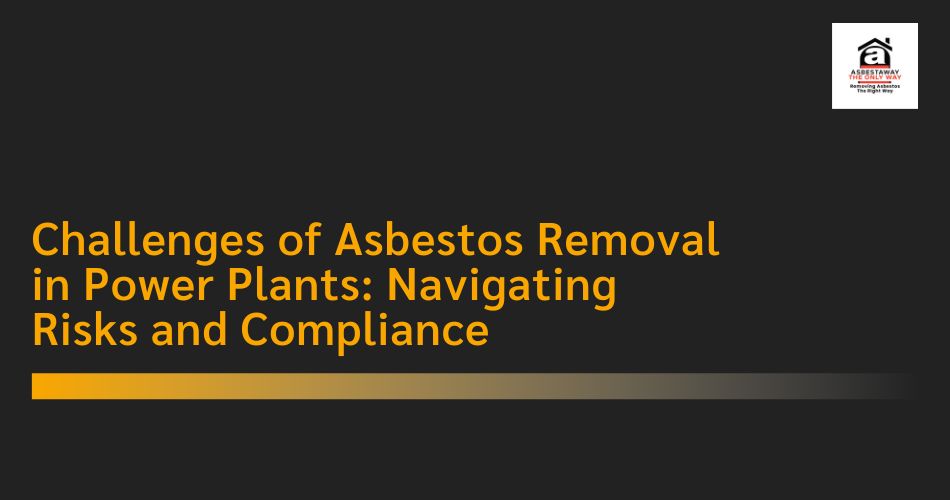Asbestos, once hailed as a miracle material for its fire-resistant properties, has been banned in many industries due to the severe health risks it poses. Power plants, like many industrial facilities, are often older structures that contain asbestos in various forms, including insulation, gaskets, pipes, and boilers. The presence of asbestos in power plants presents significant challenges when it comes to removal, as the process must be carried out with extreme caution, precision, and adherence to strict regulatory guidelines.
In this blog, we will explore the numerous challenges of asbestos removal in power plants, the risks involved, and how compliance with health and safety regulations can ensure a safer environment for workers and the surrounding community. Additionally, we will highlight how companies like Asbestaway are addressing these challenges to make the process safer and more efficient.
The Dangers of Asbestos in Power Plants
Before diving into the challenges, it is important to understand why asbestos removal is critical in power plants. Asbestos was widely used in power plants due to its excellent thermal resistance, durability, and ability to protect machinery and infrastructure from extreme heat. However, the very properties that made asbestos desirable for industrial applications are the same ones that make it hazardous.
When asbestos-containing materials (ACMs) deteriorate or are disturbed—whether during routine maintenance or decommissioning processes—tiny asbestos fibers can become airborne. Inhaling these fibers can lead to serious and often fatal diseases, such as:
- Asbestosis: A chronic lung disease caused by inhaling asbestos fibers, leading to lung scarring and breathing difficulties.
- Mesothelioma: A rare and aggressive cancer of the lining of the lungs, abdomen, or heart, almost exclusively caused by asbestos exposure.
- Lung Cancer: Prolonged asbestos exposure increases the risk of lung cancer, particularly in individuals who smoke.
- Pleural Plaques and Thickening: Non-cancerous changes to the lungs that can cause breathing problems over time.
The potential for exposure in power plants is high due to the variety of systems and machinery that contain asbestos. Asbestos fibers can easily become airborne during the removal or disturbance of ACMs, putting workers, contractors, and even nearby communities at risk. This is why removing asbestos from power plants is not just a matter of regulatory compliance—it’s a matter of protecting human health.
Challenges of Asbestos Removal in Power Plants
Asbestos removal in power plants is no easy task. It requires specialized expertise, the right equipment, and strict adherence to safety protocols. Let’s explore the primary challenges associated with asbestos removal in these complex industrial environments.
1. Complex and Aging Infrastructure
Power plants are large, complex structures that often date back several decades. These plants were constructed during a time when asbestos was heavily used for insulation and other applications. Over time, this infrastructure has aged, and many components have deteriorated, leading to the potential release of asbestos fibers.
Removing asbestos from these aging systems is a highly complex and time-consuming task. The materials containing asbestos can be hidden behind walls, pipes, or other industrial components, making it difficult to locate and remove. Identifying every potential source of asbestos contamination requires careful inspections and often invasive procedures, which can cause further damage or disruption to the plant’s operations.
2. Risk of Contamination and Worker Exposure
One of the most significant challenges of asbestos removal is minimizing the risk of exposure to workers and other individuals in the area. In power plants, workers may already be exposed to high levels of industrial pollutants, and adding asbestos to the mix can create an even more dangerous environment.
When asbestos is disturbed, even in small amounts, tiny fibers are released into the air, and these fibers can remain suspended in the air for hours or even days. Without proper containment and filtration, these fibers can spread to other parts of the plant, putting more workers and personnel at risk.
To mitigate this risk, careful precautions must be taken, including sealing off contaminated areas, using high-efficiency particulate air (HEPA) filtration systems, and ensuring that workers wear appropriate protective gear, such as respirators and full-body suits.
3. Regulatory Compliance and Legal Risks
Asbestos removal in power plants is governed by strict regulatory guidelines set by various agencies, including the Occupational Safety and Health Administration (OSHA) in the United States, the Health and Safety Executive (HSE) in the UK, and other relevant authorities worldwide. These regulations are designed to protect workers, contractors, and the surrounding community from asbestos exposure.
However, ensuring compliance with these regulations can be challenging. Non-compliance can lead to legal consequences, including hefty fines, lawsuits, and reputational damage. Moreover, failure to follow proper protocols during asbestos removal could result in the spread of asbestos fibers, which could expose workers to severe health risks.
Power plants must not only adhere to the regulations regarding asbestos removal, but they also need to ensure that the proper procedures are followed for asbestos disposal. Asbestos waste must be handled and disposed of according to specific guidelines, and power plants must maintain documentation to prove that all regulations have been met.
4. Operational Disruption and Downtime
Power plants are critical infrastructure, and any disruption to their operations can have a significant impact on the energy supply and the local economy. When asbestos removal is needed, it often requires shutting down parts of the plant or even halting operations entirely.
This downtime can be costly, especially if the plant is part of a larger, interconnected grid. Even small delays in the asbestos removal process can result in extended operational disruptions, leading to significant financial losses. Furthermore, the process of asbestos removal itself can take weeks or even months, depending on the size and complexity of the plant, leading to a prolonged shutdown period.
To minimize disruption, careful planning is required. Power plant owners and managers must coordinate with contractors to schedule asbestos removal during maintenance downtimes or other planned shutdowns to avoid any impact on the plant’s overall operations.
5. Cost Considerations
The cost of asbestos removal in power plants is a significant challenge. Asbestos removal is a labor-intensive, specialized process that requires skilled professionals and costly equipment. Additionally, the need for containment measures, air monitoring, and legal compliance can drive up the overall cost of the project.
Moreover, the larger and more complex the power plant, the higher the cost of removal. The costs associated with asbestos abatement, when not properly budgeted for, can become a major financial strain on the plant’s owners. In some cases, the cost of removal may exceed initial estimates, particularly if unforeseen complications arise, such as finding hidden asbestos-containing materials or encountering structural damage that requires additional remediation.
While the cost may be high, it’s important to note that the long-term costs of inaction are even higher, including the risk of legal fines, health-related insurance claims, and even potential lawsuits from workers who suffer from asbestos-related diseases.
Best Practices for Asbestos Removal in Power Plants
To navigate these challenges successfully, power plants must implement best practices for asbestos removal. Here are some of the key steps involved in ensuring a safe and compliant asbestos removal process:
- Pre-removal Risk Assessment: Before starting the removal process, a thorough risk assessment should be conducted to identify the locations of asbestos-containing materials, evaluate the risks of fiber release, and determine the best removal strategy.
- Containment and Isolation: Affected areas should be fully contained and isolated from the rest of the plant to prevent asbestos fibers from spreading. This includes sealing doors and vents, setting up negative air pressure systems, and using HEPA filters to capture airborne fibers.
- Personal Protective Equipment (PPE): Workers should be equipped with the appropriate PPE, including respirators, gloves, and full-body suits. Regular health checks should also be conducted to ensure workers are not exposed to asbestos.
- Proper Disposal: Asbestos-containing materials must be disposed of at licensed asbestos disposal sites, and all necessary documentation should be provided to ensure compliance with local laws.
- Air Monitoring and Clearance: After the removal process, air monitoring should be conducted to ensure that no asbestos fibers are present in the air. Clearance testing should be performed to confirm that the area is safe for re-entry.
Asbestaway: A Leader in Asbestos Removal for Power Plants
One of the leading companies tackling the challenges of asbestos removal in power plants is Asbestaway. With extensive experience in industrial asbestos abatement, Asbestaway has the expertise, resources, and commitment to ensure safe, efficient, and compliant asbestos removal.
Asbestaway offers a comprehensive range of services, from initial asbestos inspections to final clearance testing. They are fully licensed and certified to handle asbestos removal in high-risk environments such as power plants. Their team of trained professionals uses the latest equipment and techniques to ensure that the removal process is carried out safely and with minimal disruption to the plant’s operations.
Asbestaway’s commitment to safety, compliance, and quality ensures that power plant operators can trust them to handle even the most complex asbestos removal projects. By partnering with Asbestaway, power plant owners can ensure that their asbestos removal projects are completed efficiently, safely, and in full compliance with all legal and regulatory requirements.
Conclusion
Asbestos removal in power plants presents several challenges, ranging from the complexity of aging infrastructure to the risk of worker exposure and legal compliance. The need for specialized knowledge, rigorous safety protocols, and proper planning cannot be overstated. While the process may be difficult and costly, the potential risks of leaving asbestos in place are far greater.
By adhering to best practices and working with professional asbestos removal companies like Asbestaway, power plant operators can navigate these challenges successfully and ensure a safe, compliant working environment for their employees. Ultimately, ensuring the safe removal of asbestos not only protects the health of workers but also safeguards the future of the power plant and its surrounding community.

